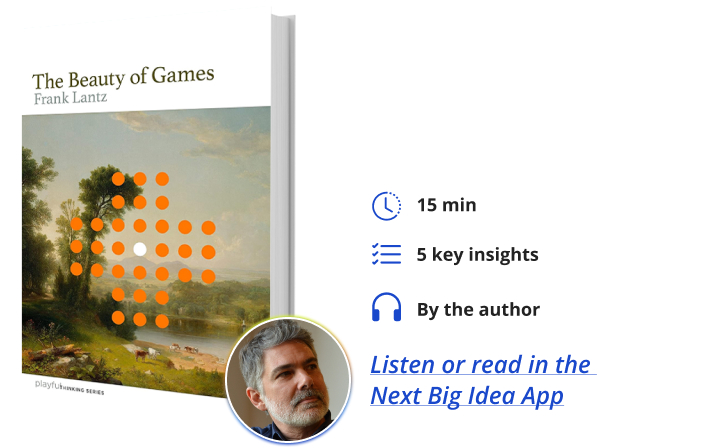Frank Lantz has taught game design for over twenty years at New York University, where he helped create the NYU Game Center and served as the founding Chair of the Game Design department from its inception until 2021. Frank is a game designer who has shipped over fifty titles, including the 2017 viral hit Universal Paperclips. In 2020, Frank created the board game Hey Robot in collaboration with his wife and son.
Below, Frank shares five key insights from his new book, The Beauty of Games. Listen to the audio version—read by Frank himself—in the Next Big Idea App.

1. Bringing games into conversation with the world.
Despite occupying an enormous amount of our time, attention, and economic interactions, games don’t seem to participate much in our collective conversations about the things that matter—our ongoing project of defining ourselves, our world, and our shared future. Literature, cinema, painting, music; each of these things has its own way of contributing to this conversation.
Games have struggled to join in, partly because of how awesome they are. Games can be so complex, absorbing, and enthralling, so rich and strange and entrancing that they often seem to create their own separate domain, one into which all of the energy and attention we can muster is swallowed up and disappears completely. But this is an illusion. Games are more than colorful, complicated pop culture. Games, like those other art forms, are a source of ideas, concepts, insights, and perspectives. They have things to tell us about the world, and this book is an attempt to listen.
2. Games are the art form of software.
Games have always been deeply entangled with computers. Long before computers existed, games were out there, dreaming them up. Then, once games had conjured computers into the world, they immediately set about asking questions. What are computers for? What do they mean? What do we want from them?
“What does it mean to see the world as a system, as a possibility space defined by constraints, affordances, and goals?”
Now that it’s too late for the world to escape being consumed by the voracious maw of computation, these questions are more important than ever. What does it mean to see the world as a system, as a possibility space defined by constraints, affordances, and goals? How does simple determinism spiral into irreducible complexity? Where do the laws of matter meet the experience of minds? What does this button do? Games are the art form that connects the logical machinery of cause and effect to the diaphanous wonders of desire and dream.
3. Music, not film.
When games are invoked as aesthetic works with something to tell us about life and the world, it is often through the conceptual lens of cinema and story. Because video games are visually spectacular, we tend to treat them as a form of screen culture. But this framing, this focus on the representational aspects of games—on characters, plots, narratives, and scenes—is impoverished and misleading.
Music is a much better analogy. Music, like games, has a lighter, more complementary relationship to representation, mimesis, and story. Music is about participation, entrainment, the songs we learn, the instruments we struggle to master, the rhythms that organize and give pattern to our perception, the mathematics of emotion, and the ways in which the separate strands of our individual attention are woven together in shared rituals of coordinated activity. Like music, the beauty of games can be hard to see. Sometimes, you have to shut your eyes and listen.
4. Thought made visible to itself.
Games are a kind of homebrew neuroscience. When you play a game, you are learning, and you are observing yourself learning. In games, the fundamental essence of what it means to be a human—to be a particular kind of cognitive process, to be an agent in the world, taking action, solving problems, pursuing goals—is given a stylized, ritualized, performative treatment. Through games, we can temporarily step outside of life, see it, and appreciate it, or simultaneously, so that we can temporarily disappear into it, give ourselves over to it, and escape it. It is a curious, sometimes awkward, dance move by which we spin around to catch ourselves in the act of thinking and doing. We are stepping out of, and disappearing into, instrumental reason.
5. Games and AI.
Games have not only the opportunity but also the responsibility to help humanity navigate the historical moment in which we find ourselves, poised on the edge of what might be the strangest and most important transition in the history of civilization. What are computers? What is thought? What is knowledge, problem-solving, and creativity? What do computers mean? What do we want from them? What is beautiful about them?
“When we make a conscious effort to improve our literacy and expand our taste, we relax and let our hearts remind us of who we really are.”
These are the kinds of conversations we have in the realm of aesthetics, when we seek out cultural works that speak to us, that give us joy or sweet sadness, that startle us with shocking novelty, or steady us with the stable truths of established tradition. When we make a conscious effort to improve our literacy and expand our taste, we relax and let our hearts remind us of who we really are. We need to make and play and think and talk about games with these questions in mind. We need to bring our experiences with games to bear on the problems and promise of AI in a way that helps us shape the future in the best possible way.
To listen to the audio version read by author Frank Lantz, download the Next Big Idea App today:































